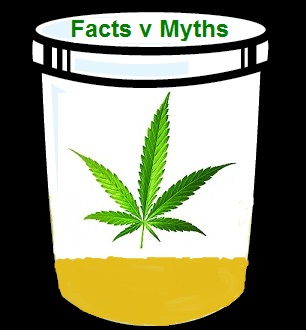How Much Do You Have to Smoke to Fail a Drug Test

MJ, a 40 years old female, presents to your pain clinic for a routine follow-up visit. You decide to run a random urine drug screen by immunoassay (IA) and she tests positive for cannabinoids.
When asked, MJ admits "I only smoked two puffs five days ago".
Fact or Myth?
Mena Raouf, a star PharmD Candidate, took a closer look at this.
Here's what he had to say…
Marijuana Pharmacokinetics
Δ9-tetrahydrocannabinol (THC) is the major psychoactive metabolite of cannabinoids, which is highly lipophilic and distributes into adipose tissue, liver, lung, and spleen. [1,3] Following inhalation, THC can be detected in the blood
As seen in figure 1 below, the psychoactive component (THC) of marijuana, undergoes hepatic hydroxylation to generate the equipotent metabolite Δ9_tetra hydrocannabinol (11-OH-THC) catalyzed by CYP 2C19 and 8β-hydroxy-Δ9-tetrahydrocannabinol (8 β -OH-THC) catalyzed by CYP 3A4. [1,3] 11-OH-THC undergoes oxidation to generate the inactive carboxy-Δ9-tetrahydrocannbinol (THCCOOH). Carboxy-Δ9-tetrahydrocannbinol is conjugated with glucuronic acid and excreted in the urine. 8β-OH-THC undergoes dehydroxylation to generate 8β,11-di-OH-THC, which indicates recent cannabinoid use if present. [1,3,4,5] However, carboxy-Δ9-tetrahydrocannbinol is the most abundant and prevalent metabolite and is ultimately the compound of interest for urine drug screening. [1,3,5]
Figure 1: Metabolism of THC Following Smoking

Urine Detection
Figure 2 illustrates how THC and its metabolites are eliminated in the urine and feces as shown in a study by Manno et al. [8] where cannabinoids were measured in the urine in 8 subjects that smoked a marijuana cigarette containing 27mg of THC. THC urine concentrations peaked at 21.5 ng/mL in 2 hours and were undetectable (<1.5 ng/mL) in 5 out of 8 subjects after 6 hours. Urine concentrations of 11-OH-THC and THC-COOH peaked at 3 hours and 4 hours respectively. THC-COOH, the compound of interest in urine drug screening, has a urinary half-life of 2-3 days. [5,6,8,10]
Figure 2: concentrations of THC metabolites in the urine following smoking [1,8]

Following a single marijuana use, THC is unlikely to be detected in the urine beyond 3 days at the 50 ng/ml cut-off level and beyond 7 days for the 20 ng/mL cutoff level. [4] For a single use based on the 50ng/mL cutoff, carboxy-Δ9-tetrahydrocannbinol can be detected in the urine within 3 days. For moderate use (4 times/week), the detection winodw is 5-7 days. For daily use, the detection window is 10-15 days with up to 30 days for long-term chronic smokers. [9] Detection times are summarized below in table 1.
Table 1: Marijuana Urine Detection (IA) Time Based on Use [7]
| Frequency of use | Detection window (days) |
| Single use | 3 days |
| Moderate use (4 times/week) | 5-7 days |
| Daily use | 10-15 days |
| Chronic heavy use | >30 days |
Now back to our patient MJ
If the patient truly smoked "2 puffs 5 days ago", then she should have tested negative based on the 50 ng/mL laboratory cut-off by immunoassay. Her positive test at this cut-off translates to moderate use (4 times/week).
Marijuana is still the most commonly detected substance of abuse on urine drug screening by IA, but let's not forget that false positives are common with cannabinoids as elucidated and identified in Dr. Fudin's Urintel Drug Application after inputting concomitant medication data. It remains a dilemma in pain management where patients with true pathologies and legitimate pain seek marijuana and other illicit substances for pain relief and anxiolytic effects. The presence of illicit substance does not necessarily negate the legitimacy of the patient's pain complaints, but it may suggest the presence of concurrent disorder such as substance abuse or "chemical coping". The patient must be willing to work with the healthcare team to receive treatment for both disorders; that is a decision the patient has to make.

This article was collaboratively written with Mena Raouf, a 2016 PharmD Candidate at the Albany College of Pharmacy and HealthSciences with a concentration in Nephrology. Mena moved out of Egypt 5 years ago to start pharmacy school and career in the U.S. He hopes to complete PGY1 and PGY2 Pharmacy Residency and practice as a clinical pharmacist specialist. He is currently under the mentorship of Dr. Fudin studying pain management.
References:
- Lapoint JM. Cannabinoids. In: Hoffman RS, Howland M, Lewin NA, Nelson LS, Goldfrank LR. eds. Goldfrank's Toxicologic Emergencies, 10e. New York, NY: McGraw-Hill; 2015.
- McBurney LJ, Bobbie BA, Sepp LA. GC/MS and EMIT analyses for delta 9-tetrahydrocannabinol metabolites in plasma and urine of human subjects. J Anal Toxicol. 1986;10:56–64.
- Grotenhermen F: Pharmacokinetics and pharmacodynamics of cannabinoids. Clin Pharmacokinet. 2003;42:327–360.CrossRef [PubMed: 12648025]
- Smith-kielland A, Skuterud B, Morlan J. Urinary Excretion of 11-nor-9-Carboxy-AgTetrahydrocannabinol and Cannabinoids in Frequent and Infrequent Drug Users. Journal of Analytical Toxicology, Vol. 23, September 1999
- Huestis M, Mitchel JM, Cone EJ. Urinary Excretion Profiles of 11-Nor-9-Carboxy-AgTetrahydrocannabinol in Humans after Single Smoked Doses of Marijuana. Journal of Analytical Toxicology, Vol. 20, October 1996
- Goodwin RS, Darwin WD, Chaing N et al. Urinary Elimination of 11-Nor-9-carboxy- 9-tetrahydrocannnabinolin Cannabis Users During Continuously Monitored Abstinence. J Anal Toxicol. 2008 October ; 32(8): 562–569.
- Moeller KE, Lee KC, Kissack JC. Urine Drug Screening:Practical Guide for Clinicians. Mayo Clin roc. January 2008;83(1):66-76
- Manno JE, Manno BR, Kemp PM et al.: Temporal indication of marijuana use can be estimated from plasma and urine concentrations of delta9-tetrahydrocannabinol, 11-hydroxy-delta9-tetrahydrocannabinol, and 11-nor-delta9-tetrahydrocannabinol-9-carboxylic acid. J Anal Toxicol. 2001;25:538–549
- Detection time of drugs of abuse in urine.Vandevenne M, Vandenbussche H, Verstraete A Acta Clin Belg. 2000 Nov-Dec; 55(6):323-33.
- Karschner EL, Schwilke EW, Lowe RH et al. Implications of plasma Delta9-tetrahydrocannabinol, 11-hydroxy-THC, and 11-nor-9-carboxy-THC concentrations in chronic cannabis smokers. J Anal Toxicol. 2009 Oct; 33(8):469-77.
- http://www.snp.com.au/media/335235/urine-jar-cartoon.gif
- http://sr.photos3.fotosearch.com/bthumb/CSP/CSP993/k14868307.jpg
How Much Do You Have to Smoke to Fail a Drug Test
Source: https://paindr.com/two-puffs-too-bad-demystifying-marijuana-urine-testing/
0 Response to "How Much Do You Have to Smoke to Fail a Drug Test"
Post a Comment